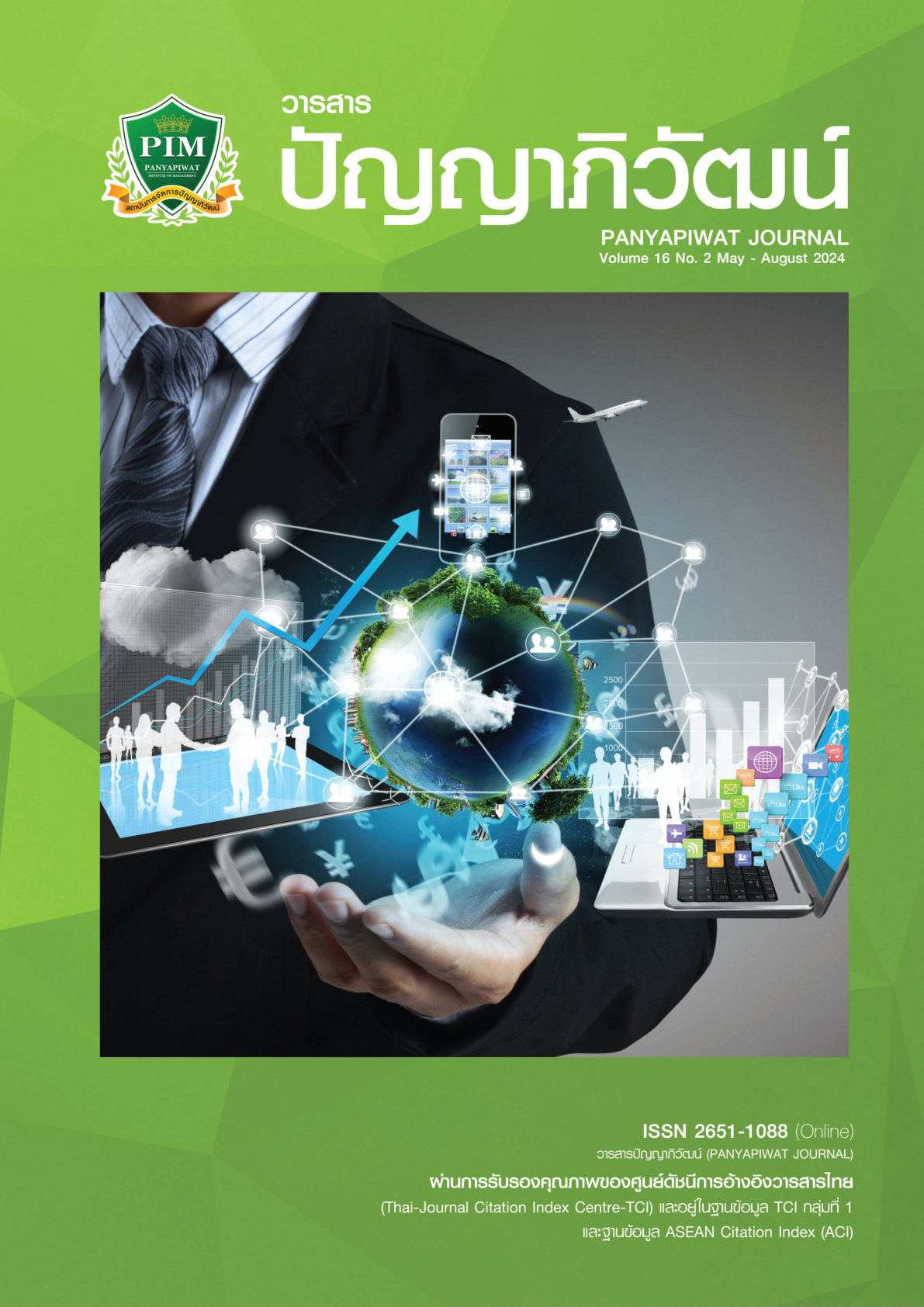ผลของการใช้กระบวนการเรียนรู้ด้วยเกมเป็นฐานผ่านเกมไมน์คราฟต์ฉบับเพื่อการศึกษาสำหรับเด็กและเยาวชนไทย
Main Article Content
บทคัดย่อ
การวิจัยครั้งนี้มีวัตถุประสงค์เพื่อพัฒนากระบวนการเรียนรู้ด้วยเกมเป็นฐานและเพื่อศึกษาผลของการใช้กระบวนการเรียนรู้ด้วยเกมเป็นฐานผ่านเกมไมน์คราฟต์ฉบับเพื่อการศึกษาสำหรับเด็กและเยาวชนไทยคณะผู้วิจัยเก็บรวบรวมข้อมูลผ่านการวิจัยและพัฒนา 5 รอบ ตลอดระยะเวลา 5 เดือน จากกลุ่มตัวอย่างที่ได้มาด้วยวิธีการสุ่มอย่างง่าย ได้แก่ นักเรียนประถมศึกษาตอนปลาย 20 คน และนักเรียนมัธยมศึกษาตอนต้น 20 คน
รวมทั้งสิ้น 40 คน จากนั้นคณะผู้วิจัยดำเนินการสนทนากลุ่มร่วมกับผู้เชี่ยวชาญ จำนวน 7 คน เครื่องมือที่ใช้ในการวิจัย ได้แก่ แบบสังเกตและแบบประเมิน การวิเคราะห์ข้อมูลจากการสังเกตด้วยการวิเคราะห์แก่นสาระ เพื่อค้นพบข้อมูลที่แท้จริง และวิเคราะห์ข้อมูลจากแบบประเมินด้วยค่าร้อยละ ผลการวิจัยพบว่า การเรียนรู้ด้วยเกมเป็นฐานผ่านเกมไมน์คราฟต์ฉบับเพื่อการศึกษา มีประสิทธิผลสูงสุดเมื่อใช้สื่อเกมควบคู่กับสื่อใบงานการประเมินผลท้ายคาบเรียน การทำกิจกรรมกลุ่ม และการนำเสนอผลงาน ซึ่งช่วยยกระดับพัฒนาการนักเรียน2 มิติ ดังนี้ 1) ด้านพุทธิพิสัย ได้แก่ ความรู้ความเข้าใจเชิงทฤษฎี ทักษะการคิดวิเคราะห์ ทักษะการคิดวิพากษ์ทักษะการคิดเชิงตรรกะ ทักษะการคิดสร้างสรรค์ และทักษะการแก้ปัญหา และ 2) ด้านจิตพิสัย ได้แก่ความสามารถในการควบคุมอารมณ์ตนเอง การแสดงออกเชิงพฤติกรรมภายใต้กฎกติกา ความสามารถในการยอมรับความแตกต่างทางความคิด ทักษะการทำงานเป็นทีม ทักษะความร่วมมือ และทัศนคติเชิงบวกต่อการเรียนรู้
Article Details

อนุญาตภายใต้เงื่อนไข Creative Commons Attribution-NonCommercial-NoDerivatives 4.0 International License.
“ข้าพเจ้าและผู้เขียนร่วม (ถ้ามี) ขอรับรองว่า บทความที่เสนอมานี้ยังไม่เคยได้รับการตีพิมพ์และไม่ได้อยู่ระหว่างกระบวนการพิจารณาลงตีพิมพ์ในวารสารหรือแหล่งเผยแพร่อื่นใด ข้าพเจ้าและผู้เขียนร่วมยอมรับหลักเกณฑ์การพิจารณาต้นฉบับ ทั้งยินยอมให้กองบรรณาธิการมีสิทธิ์พิจารณาและตรวจแก้ต้นฉบับได้ตามที่เห็นสมควร พร้อมนี้ขอมอบลิขสิทธิ์บทความที่ได้รับการตีพิมพ์ให้แก่สถาบันการจัดการปัญญาภิวัฒน์หากมีการฟ้องร้องเรื่องการละเมิดลิขสิทธิ์เกี่ยวกับภาพ กราฟ ข้อความส่วนใดส่วนหนึ่งและ/หรือข้อคิดเห็นที่ปรากฏในบทความข้าพเจ้าและผู้เขียนร่วมยินยอมรับผิดชอบแต่เพียงฝ่ายเดียว”
เอกสารอ้างอิง
Bloom, B. S. (1956). Taxonomy of educational objectives, Book I: Cognitive domain. David Mckay.
Bunnag, N. (2022, May 6). Develop skills and knowledge for children of all ages with over 500 lessons through playing popular games “Minecraft: Education Edition”. SDG MOVE. https://www.sdgmove.com/2022/05/06/minecraft-education-edition/ [in Thai]
Dezuani, M., & Marci, J. (2020). Minecraft: Education edition for educational impact. Queensland University of Technology’s Digital Media Research Centre, 2, 1-148.
Dooland, L. (2022). NPD group reveals “Top 10 most played games” of Q1 2022 (US). https://www.nintendolife.com/news/2022/05/npd-group-reveals-top-10-most-played-gamesof-q1-2022-us
Hacıoğlu, Y., & Dönmez Usta, N. (2020). Digital game design-based STEM activity: Biodiversity example. Science Activities, 57(1), 1-15.
Heiden, J. M., Braun, B., Muller, K. M., & Egloff, B. (2019). The association between video gaming and psychological functioning. Frontiers in Psychology, 10, 1-11.
Herliandry, L. D., Kuswanto, H., & Hidayatulloh, W. (2021). Improve critical thinking ability through augmented reality assisted worksheets. In 6th International Seminar on Science Education (ISSE 2020) (pp. 470-475). Atlantis Press.
Karsenti, T., Bugmann, J., & Gros, P. P. (2017). Transforming education with Minecraft? Results of an exploratory study conducted with 118 elementary-school students. CRIFPE.
Legends of Learning. (2016). James Gee’s principles for game based learning. https://www.legendsoflearning.com/blog/james-paul-gee-game-based- learning/
Manager Online. (2019). 10 years of “Minecraft”, total worldwide sales reach 176 million sets. https://mgronline.com/game/detail/9620000048164 [in Thai]
McDaniel, R., & Telep, P. (2009). Best practices for integrating game-based learning into online teaching. Journal of Online Learning and Teaching, 5(2), 424-438.
Mutia, N. B., & Prasetyo, Z. K. (2018). The Effectiveness of students’ worksheet based on multiple representations to increase creative thinking skills. Journal of Education and Learning (EduLearn), 12(4), 631-637.
National Health Commission Office. (2021). Research results show that children and youth are addicted to games for an average of 5 hours/day. Expenses 5,000 baht/month. National Health Commission Office (NHCO). https://www.nationalhealth.or.th/th/node/3006 [in Thai]
Pontes, H. M., Schivinski, B., Sindermann, C., Li, M., Becker, B., Zhou, M., & Montag, C. (2021). Measurement and conceptualization of gaming disorder according to the world health organization framework: The development of the gaming disorder test. International Journal of Mental Health and Addiction, 19, 508-528.
Rajan, S. S. (2022). Effectiveness of game based learning to enhance student learning. Technoarete Transactions on Application of Information and Communication Technology (ICT) in Education, 1, 6-11.
Shehabat, I. M., & Mahdi, S. A. (2009). E-Learning and its impact to the educational system in the Arab world. In 2009 International Conference on Information Management and Engineering (pp. 220-225). IEEE.
Thinking U Know: TUK. (2015). Factsheet Minecraft (for parents). TninkUKnow Australia. https://castlehillp.schools.nsw.gov.au/content/dam/doe/sws/schools/c/castlehill-p/cybersafety/MinecraftParents_FA_web.pdf
Trybus, J. (2015). Game-based learning: What it is, why it works, and where it’s going. New Media Institute.
Wardoyo, C., Satrio, Y. D., & Ma’ruf, D. (2019). Effectiveness of game-based learning-learning in modern education. In The 3rd International Research Conference on Economics and Business, KnE Social Sciences (pp. 81-87). Universitas Negeri Malang (UM). https//:doi.org/10.18502/kss.v4i7.6844
White, K., & McCoy, L. P. (2019). Effects of game-based learning on attitude and achievement in elementary mathematics. Networks: An Online Journal for Teacher Research, 21(1), 1-17. https://doi.org/10.4148/2470-6353.1259
Yab, C. (2015). Microsoft brings in the famous game Minecraft to encourage Thai children to become interested in computer science. https://news.microsoft.com/th-th/2015/12/19/hoc_th/


